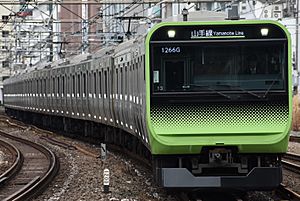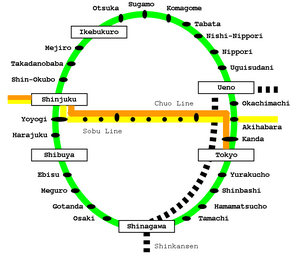Yamanote Line facts for kids
The Yamanote Line (山手線 (Yamanote-sen)) is a very important railway line in Tokyo, Japan. It's run by the East Japan Railway Company (JR East). This line is one of Tokyo's busiest and connects many major stations and city centers. These include places like Shibuya, Shinjuku, Ikebukuro, and Ueno. Almost all of its 29 stations connect to other train or subway lines.
When people say "Yamanote Line," they usually mean the whole 34.5 km (about 21.4 miles) loop. This loop is used by local trains that go around in a circle. There's also a "Yamanote Freight Line" next to it, which is used by other train lines and cargo trains. But most of the time, "Yamanote Line" means the famous circular passenger train.
Contents
History of the Yamanote Line
How the Line Started
The Yamanote Line first opened in 1909. Back then, it was called the "Shinagawa Line." It ran between Shinagawa and Akabane. Each train had 10 cars.
Becoming a Loop
The line became a full circle in 1925. This meant trains could go all the way around Tokyo. In 1925, about 5 trains ran every hour, and a full trip took 72 minutes. By 2014, trains ran 25 times an hour, and a full trip was only 60 minutes!
Changes Over Time
The trains on the Yamanote Line have changed colors a few times.
- In 1961, the trains changed from brown to yellow.
- In 1972, they changed again, this time to the famous green color you see today.
- In 1987, the Japan Railway system became a private company, and JR East took over the Yamanote Line.
- In 1990, more cars were added to the trains, making them longer.
- Since 2000, you can see special advertisements wrapped around the trains.
- For the 2020 Olympics in Tokyo, platform screen doors were added at each station to make them safer.
Cool Facts About the Yamanote Line
How Trains Run
The Yamanote Line is quite special because it doesn't use traditional signals. Instead, each train simply follows the train in front of it. This helps keep things moving smoothly.
Trains and Crossings
The Yamanote Line carries both passenger trains (for people) and freight trains (for goods). Even though it's a very busy line, it has only one railway crossing where cars or people can cross the tracks at ground level.
How Many People Use It?
The Yamanote Line is incredibly popular. In 2013, about 3,238,000 people used the Yamanote Line every single day! That's a lot of passengers!
Yamanote Line Stations
Here is a list of the stations on the Yamanote Line. It shows how far apart they are and what other train lines you can connect to at each station.
| Line1 | Station | In Japanese | Distance2 | Transfers | Location | ||
|---|---|---|---|---|---|---|---|
| JR East | Other Lines | ||||||
| Yamanote Line |
Shinagawa | 品川 | 2.2 | 0.0 |
■Tōkaidō Main Line |
JR Central: Tōkaidō Shinkansen Keikyu: Main Line |
Minato |
| Ōsaki | 大崎 | 2.0 | 2.0 |
■Shōnan-Shinjuku Line |
Rinkai Line | Shinagawa | |
| Gotanda | 五反田 | 0.9 | 2.9 | Tōkyū: Ikegami Line Toei: ○Asakusa Line (A-05) |
|||
| Meguro | 目黒 | 1.2 | 4.1 | Tōkyū: Meguro Line Tokyo Metro: ○Namboku Line (N-01) Toei: ○Mita Line (I-01) |
|||
| Ebisu | 恵比寿 | 1.5 | 5.6 |
■Shōnan-Shinjuku Line |
Tokyo Metro: ○Hibiya Line (H-02) | Shibuya | |
| Shibuya | 渋谷 | 1.6 | 7.2 |
■Shōnan-Shinjuku Line |
Keio: Inokashira Line Tōkyū: Den-en-toshi Line, Tōyoko Line Tokyo Metro: ○Ginza Line (G-01), ○Hanzōmon Line (N-01), ○Fukutoshin Line (F-16) |
||
| Harajuku | 原宿 | 1.2 | 8.4 | Tokyo Metro: ○Chiyoda Line (at Meiji-jingūmae, C-03) | |||
| Yoyogi | 代々木 | 1.5 | 9.9 |
■Chūō-Sōbu Line |
Toei: ○Ōedo Line (E-26) | ||
| Shinjuku | 新宿 | 0.7 | 10.6 |
■Chūō Main Line |
Keio: Keiō Line, Keio New Line Odakyu: Odawara Line Seibu: Shinjuku Line (at Seibu-Shinjuku) Tokyo Metro: ○Marunouchi Line (M-08) Toei: ○Shinjuku Line (S-01), ○Ōedo Line (at Shinjuku (E-27) and Shinjuku-Nishiguchi (E-01)) |
Shinjuku | |
| Shin-Ōkubo | 新大久保 | 1.3 | 11.9 | ||||
| Takadanobaba | 高田馬場 | 1.4 | 13.3 | Seibu: Shinjuku Line Tokyo Metro: ○Tōzai Line (T-03) |
|||
| Mejiro | 目白 | 0.9 | 14.2 | Toshima | |||
| Ikebukuro | 池袋 | 1.2 | 15.4 |
■Shōnan-Shinjuku Line |
Seibu: Ikebukuro Line Tobu: Tōjō Line Tokyo Metro: ○Marunouchi Line (M-25), ○Yūrakuchō Line (Y-09), ○Fukutoshin Line (F-09) |
||
| Ōtsuka | 大塚 | 1.8 | 17.2 | Toden Arakawa Line at Ōtsuka Ekimae Station | |||
| Sugamo | 巣鴨 | 1.1 | 18.3 | Toei: ○Mita Line (I-15) | |||
| Komagome | 駒込 | 0.7 | 19.0 | Tokyo Metro: ○Namboku Line (N-14) | |||
| Tabata | 田端 | 1.6 | 20.6 |
■Keihin-Tōhoku Line (R) |
Kita | ||
| Tōhoku Main Line |
|||||||
| Nishi-Nippori | 西日暮里 | 0.8 | 21.4 |
■Keihin-Tōhoku Line |
Tokyo Metro: ○Chiyoda Line (C-16) Nippori-Toneri Liner |
Arakawa | |
| Nippori | 日暮里 | 0.5 | 21.9 |
■Jōban Line |
Keisei: Main Line Nippori-Toneri Liner |
||
| Uguisudani | 鶯谷 | 1.1 | 23.0 | Taitō | |||
| Ueno | 上野 | 1.1 | 24.1 |
■Shinkansen (Tōhoku, Jōetsu, Nagano, Yamagata, Akita) |
Keisei: Main Line (at Keisei Ueno) Tokyo Metro: ○Ginza Line (G-16), ○Hibiya Line (H-17) |
||
| Okachimachi | 御徒町 | 0.6 | 24.7 |
■Keihin-Tōhoku Line |
|||
| Akihabara | 秋葉原 | 1.0 | 25.7 |
■Chūō-Sōbu Line |
Tsukuba Express Tokyo Metro: ○Hibiya Line (H-15) |
Chiyoda | |
| Kanda | 神田 | 0.7 | 26.4 |
■Chūō Line (Rapid) |
Tokyo Metro: ○Ginza Line (G-13) | ||
| Tokyo | 東京 | 1.3 | 27.7 |
■Shinkansen (Tōhoku, Jōetsu, Hokuriku, HokkaidōYamagata, Akita) |
JR Central: Tōkaidō Shinkansen Tokyo Metro: ○Marunouchi Line (M-17) |
||
| Tōkaidō Main Line |
|||||||
| Yūrakuchō | 有楽町 | 0.8 | 28.5 |
■Keihin-Tōhoku Line |
Tokyo Metro: ○Yūrakuchō Line (Y-18), ○Hibiya Line (at Hibiya, H-07), ○Chiyoda Line (at Hibiya, C-09) Toei: ○Mita Line (at Hibiya, C-09) |
||
| Shimbashi | 新橋 | 1.1 | 29.6 |
■Tōkaidō Main Line |
Tokyo Metro: ○Ginza Line (G-08) Toei: ○Asakusa Line (A-10) Yurikamome |
Minato | |
| Hamamatsuchō | 浜松町 | 1.2 | 30.8 |
■Keihin-Tōhoku Line (R) |
Tokyo Monorail Toei: ○Asakusa Line (at Daimon, A-09), ○Ōedo Line (at Daimon, E-20) |
||
| Tamachi | 田町 | 1.5 | 32.3 |
■Keihin-Tōhoku Line (R) |
|||
| Shinagawa | 品川 | 2.2 | 34.5 | See above. | |||
Notes
- 1: Official line names
- 2: The left number is the distance from the station before it (in kilometers). The right number is the total distance from Shinagawa Station (in kilometers).
- 3: "(R)" means that the rapid trains on the Keihin-Tōhoku Line stop here.
Related pages
Images for kids
See also
 In Spanish: Línea Yamanote para niños
In Spanish: Línea Yamanote para niños









